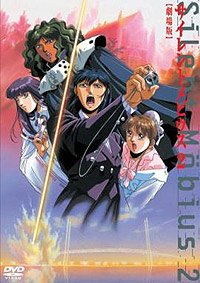Sairento Mebiusu 2 |

Japan • 1992 • 58m •
     • Directed by: Yasunori Ide. • Starring: Gorô Naya, Lisa Ann Beley, Don Brown, Trevor Devall, Paul Dobson, Toshiko Fujita, Marcy Goldberg, Kôichi Hashimoto, Maryke Hendrikse, Chieko Honda, Masako Ikeda, Janyse Jaud, Taeko Kawata.. • Directed by: Yasunori Ide. • Starring: Gorô Naya, Lisa Ann Beley, Don Brown, Trevor Devall, Paul Dobson, Toshiko Fujita, Marcy Goldberg, Kôichi Hashimoto, Maryke Hendrikse, Chieko Honda, Masako Ikeda, Janyse Jaud, Taeko Kawata..  After the dreadful events related to her mother, Katsumi Liqueur has just one thing in mind: To leave this horrible town as fast as possible, a town where she knows nobody and has no friends. But she soon faces serious obstacles as Rally Cheyenne, the commander of the Attacked Mystification Police, hasn't given up her plan to recruit Katsumi for her team in order to defend the citizens against the Lucifer Hawk demons. And the AMP aren't the only ones interested in making use of Katsumi's magical powers... After the dreadful events related to her mother, Katsumi Liqueur has just one thing in mind: To leave this horrible town as fast as possible, a town where she knows nobody and has no friends. But she soon faces serious obstacles as Rally Cheyenne, the commander of the Attacked Mystification Police, hasn't given up her plan to recruit Katsumi for her team in order to defend the citizens against the Lucifer Hawk demons. And the AMP aren't the only ones interested in making use of Katsumi's magical powers...
|
Trailers:
| Length: | Languages: | Subtitles: |
Review:











Normally in anime of this type, all this would have been a build-up to an action finale where the heroine accepts her destiny, unleashes her power, and wreaks havoc on her demonic opponents, but the resolution here is abrupt and unsatisfying and clearly designed to set up a sequel or TVvideo series that never materialized. It even says "To be continued," in English, at the very end. There was a "Silent Mobius" TV series in 1998, six years later, but it was a complete reboot and not an actual sequel. So SILENT MOBIUS 2 seems strangely incomplete. Another half-hour wouldn't have hurt it. Nor would it have hurt to simply tell the whole story in a normal full-length animated feature, instead of two short films that don't quite succeed in making full dramatic use of the imaginative concepts introduced. (The first movie does, at least, offer much more occult battle action.)
Still, I'm impressed with the design and animation style and general tone of the piece, all enhanced by the full-bodied orchestral score (by Kaoru Wada). There are scenes in this sequel that are quite evocative, as when Katsumi recalls dreams of the Rainbow Bridge over Tokyo Bay and then seeks to find the spot in reality that matches the angle she saw in her dream. (The bridge is now in ruins, evidently damaged during the unexplained catastrophe.) There's also a very moving scene where she finds the house she lived in with her mother as a girl and walks through dark, dusty halls with flashbacks to her childhood. However, the effectiveness of these scenes is undermined by Katsumi's continually tiresome behavior as she rejects all entreaties to step up to the plate and help in the fight. In the later TV series, Katsumi resists joining AMP for the first two episodes, but only because she wants more information about Lucifer Hawk (as the demonic entity is called in the TV series) and her father's connection to them before she signs on. By the end of episode 2, she's fully on board and ready for action in half the time it took in these two movies.
Review by Brian Camp from the Internet Movie Database.
Movie Database